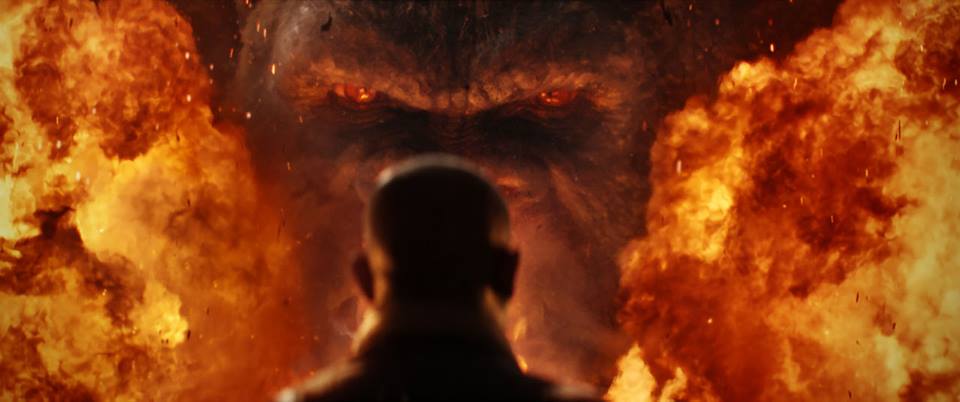SPOILERS
 (3.5 / 5)
(3.5 / 5)
A U.S. flyboy plummets out of the sun; hooked to a parachute.
His fighter plane death-spiraling into a flaming wreck on the white sand of Pacific beach. His panicked grappling with a Japanese pilot, his nemesis; a battle to the death on a clifftop drenched in searing light. Suddenly, a huge simian hand. Another. A giant, snarling face. Kong!
The second installment in Legendary Pictures’ MonsterVerse – after 2014’s Godzilla – Kong: Skull Island assumes, not unfairly, that we’re all well-versed when it comes to Kong. Even Peter Jackson’s epic three-hour telling couldn’t get away from that iconic ending: biplane-swatting, blonde-loving monkey takes a header off the side of the Empire State Building. This new Kong is, by comparison, something of a homebody.
Kicking things off Stateside, the film opens in Washington, D.C., circa 1973. The obsessive Will Randa (John Goodman), a senior member in the Monarch organization, has come seeking government funding for an expedition to a mysterious island off the coast of Sumatra. As his seismologist subordinate Brooks (Corey Hawkins) says, if they don’t, the Russians might; and who knows what resources they might discover.
So far so Cold War, but Skull Island takes as its inspiration from a different, somewhat more turbulent American conflict. Francis Ford Coppola famously said that Apocalypse Now was Vietnam. Skull Island is Vietnam movies – just call it (thank you, Alex Leadbeater, for this) “Viet Kong”.
Dan Gilroy and Max Borenstein’s script is packed with ideas and homages to everything from Heart of Darkness to Platoon. I’ve otherwise called a moratorium on the use of CCR in Vietnam films, but the film is so knowing with it that what would otherwise seem cliche passes for cool.
Meanwhile, bringing the Sheen to proceedings (sorry) is Tom Hiddleston’s hunter-tracker Conrad, whose neon-drenched introduction in a seedy opium den feels like the best big-screen try-out he’s yet had for being Bond; even if the film can’t quite maintain the sense of danger.
Brie Larson’s photojournalist Weaver, meanwhile, is just as cool, but her presence seems mostly calculated to allow for the stylistic flourish of period-style photos which otherwise serve no narrative purpose.
They’re accompanied by a military escort, the Sky Devils helicopter squadron, led by Captain Packard (Samuel L. Jackson), who’s more than willing to set off to some uncharted island rather than return home. Unbeknownst to him, though, his men – Shea Whigham’s weary oddball, Toby Kebbell’s dad-away-from-home (something of a specialty after A Monster Calls) – are shortly to become monster fodder.
Skull Island here may be less fortressed than its previous incarnation – less bleak and grey, more Halong Bay – but it’s certainly no less hostile. No sooner have the expedition started dropping explosive “probes” than Kong himself makes an appearance; seeming to materialize from the midst of nowhere, as he is want to do – call it “gorilla warfare” – and taking them to ask for their unwarranted intrusion.
Despite a shot of the fire reflected in the golden Aviators of a grinning airman, the film avoids the obvious subtext that “man is the real monster”; as seems to be a requisite in all John Goodman films of late. Instead, this is a survival movie – man v. nature in the form of giant, bamboo-legged spider/squid/skull-crawler. The rare blockbuster that truly avoids IMAX 3D – if you’re going to see a giant monkey movie, you might as well see it to scale – a POV sequence inside a crashing helicopter feels like it’s been ripped straight from a Universal ride.
Kong himself is substantially larger and more battle-worn and, even if the CG is no longer as impressive as it was twelve years ago, seems more than ready to go toe-to-toe/fist-to-claw with any of the Toho canon.
Of the human cast, MVP likely belongs to John C. Reilly as a slightly loopy All-American castaway, Hank Marlow, whose time spent with the mostly non-verbal natives of the island has left him unable to suppress his internal monologue. As the extended cast are maimed and munched by the deadly ecosystem and Packard goes the way of Captain Ahab, Marlow serves as a crucial advocate for Kong as protector of the island.
The film is less interesting when it settles into this rhythm – some people get maimed or munched, suddenly or heroically; others don’t – but the spectacle is at least on the level of, say, Jurassic World. Former indie director Jordan Vogt-Roberts presents it with tremendous gloss and flair. He has an eye for the impactful insert – like the Nixon bobblehead bobbling furiously on the dashboard of a crashing chopper.
Cinematographer Larry Fong, redeeming himself somewhat for Batman V Superman, throws in splashes of hyper-natural vibrancy – green mist, blue blood – while making the most of the natural beauty on display.
Kong: Skull Island is by no means the only blockbuster coming out this year to feature photo-realistic CGI apes – the other is, of course, War For The Planet Of The Apes – but it was almost certainly be the most entertaining.
